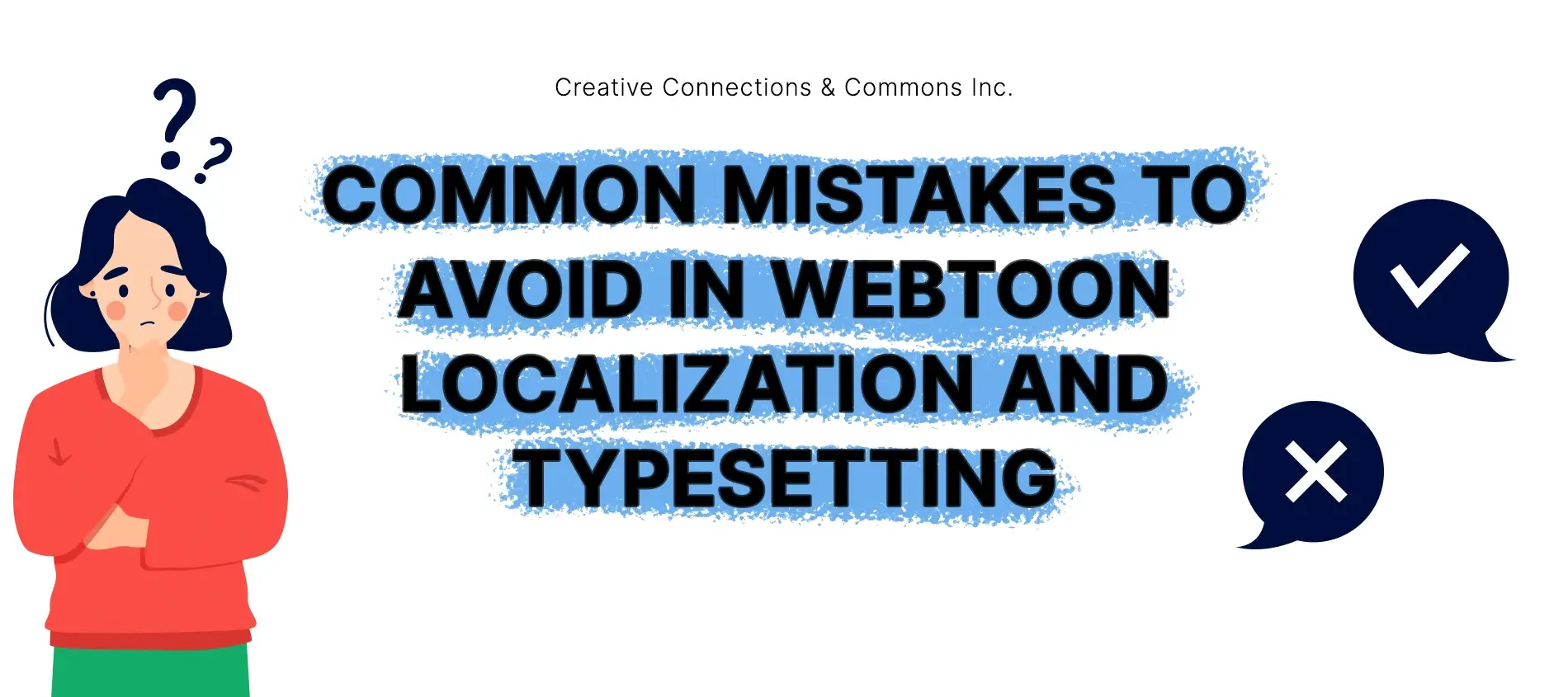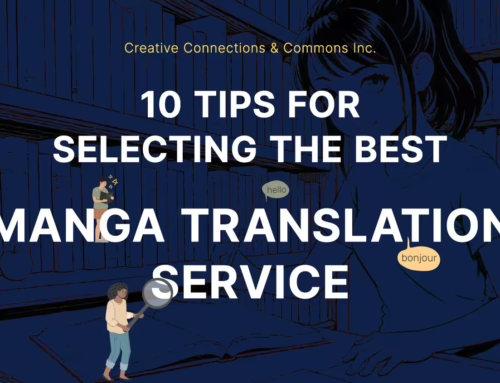Key Takeaways:
- High-quality webtoon localization and typesetting ensure the success of adapting webtoons for a wider global audience.
- Common webtoon typesetting and localization mistakes may often come as a result of technical inconsistencies.
- For a polished webtoon, ensure that natural dialogue, character voice, SFX localization, cultural adaptation, naming conventions, font selection, balanced speech bubbles, and formatting styles are consistent throughout.
- CCC is a professional webtoon localization service that specializes in more than 30 languages worldwide.
Table of Contents:
- Webtoon Localization and Typesetting
- Common Webtoon Typesetting and Localization Mistakes
- Webtoon Localization and Typesetting Tips
- CCC: Webtoon Localization Services
High-quality webtoon localization and typesetting ensure the success of adapting webtoons for a wider global audience. We’ve already seen countless examples of webtoon comics adapted into shows, especially in K-Drama, and they are also readily available to read in any language online.
With the emergence of several online platforms like Naver and Tapas, webtoons continue to flourish and dominate the comic scene. Because of this popularity, more and more translations are made to accommodate different audiences worldwide. Of course, besides high-quality translations, webtoon localization and typesetting are also indirectly appreciated by readers for improving their reading experience.
As a professional webtoon localization services company, CCC brings you the list of common mistakes to avoid in webtoon translation and webtoon typesetting tips! We’ve got the details for you below!
Webtoon Localization and Typesetting
First of all, let’s have a look at webtoon localization and typesetting. With easy Internet access and various online platforms, localization plays an important role in making sure the webtoons are relatable to readers regardless of nationality and cultural background.
More than translation, localization takes into consideration the cultural and visual elements within the webtoon story and makes sure that the target audience can understand and relate to it. However, it does not mean that every aspect must be changed in the story, as it would alter the whole essence of the story.
Localization blends authenticity with relatability, as they say. It adapts the cultural nuances of a language to another, including humor and idiomatic expressions. This is in a way that connects with readers without altering the whole structure of the story.
On the other hand, webtoon typesetting involves the technical aspects of the whole translation process. The process of typesetting comes in after translating the text from one language to another, using computer software like Photoshop. This involves the visual harmony of the text, sound effects, and font styles.
Elements of Webtoon Typesetting
Various typesetting services follow their set of guidelines; however, as a rule of thumb, here are the common elements in webtoon typesetting:
- Cleaning and Redrawing. This process involves removing texts of the original language from bubbles, captions, and sound effects for the new translated text. In some cases, a redrawing is done for texts not placed in bubbles to manually restore effects that were previously cleaned.
- Font Selection. The process of selecting fonts is not as easy as it sounds. Webtoons utilize several types of fonts for different purposes. Choosing the correct narration fonts, dialogue fonts, SFX fonts, and emphasis fonts would accurately convey emotions and tone.
- Text Formatting. The process of formatting text refers to ensuring that texts are readable, natural, and visually appealing by adjusting the appearance of the translated text. Text formatting includes elements such as size and space formats, text alignment and positioning, utilizing font styles like bold, italics, and capitalization, as well as text shapes and special effects.
- Bubble and Text Placement. Typesetting is also about maintaining speech bubbles and text placement. This process maintains visual harmony, smooth readability, and the flow of the webtoon. It includes the position of the speech bubble, text centering and spacing, dialogue flow, and bubble pointers placement.
- Sound Effects (SFX) Recreation. Sound effects, or SFX, are text-based representations of sounds and onomatopoeia. As this element is typically not inserted in speech bubbles, it usually undergoes cleaning and redrawing. Key aspects of recreating sound effects include SFX translation, style and placement matching, blending into the artwork, and choosing the appropriate fonts.
- Quality Assurance. The process of quality assurance is an important aspect in webtoon typesetting. It is the final review process, where typesetters check for inconsistencies and typographical errors in the material before it is published. Key elements of quality assurance include checking readability and accuracy, font styles, text placements, and seamless visual harmony.
Common Webtoon Typesetting and Localization Mistakes
Now that we’ve covered the basic elements of webtoon localization and typesetting, we will discuss the common webtoon typesetting and localization mistakes. Common webtoon typesetting and localization mistakes may often come as a result of technical inconsistencies. We’ve listed five common points of webtoon typesetting mistakes and webtoon localization mistakes.
Webtoon Typesetting Mistakes
Sometimes, we often overlook how typesetting can affect the overall flow of a webtoon. Poor typesetting affects the whole reading process and so may disrupt the reader’s immersive experience. High chances are, poorly typeset webtoons are likely to be dropped. Here are common webtoon typesetting mistakes that you might unconsciously make.
- Inconsistent Choice of Font. Fonts are an important aspect in webtoon typesetting. As previously mentioned, different kinds of fonts are used for different uses – narrative, dialogue, SFX, and emphasis. Font choices become a common mistake in typesetting when it is used inconsistently and do not match their intended use. For example, using robotic-looking fonts for emotional dialogues disrupts readability, making them look out of place.
- Bad Text Replacement and Balloon Spacing. Text replacements and bubble spacing can be flawed when texts do not fit well inside the speech bubble. Other common mistakes also include misaligned texts, text touching the edges, and uneven or awkward line breaks.
- Poor Line Breaks & Kerning. Line break flaws include unnatural line breaks, where it can be too short or too long, and create an unbalanced look. Kerning, or text spaces, can be too tight or too loose, which makes the text look inconsistent.
- Low Contrast or Hard-to-Read Texts. Poor color choices affect text visibility and thus disrupt the reading experience. Hard-to-read texts can be due to poor color contrast, or using light-colored text on a light background, using inappropriate text effects like glow or shadow, and blending texts into the background.
- Overuse or Lack of Emphasis Style. Emphasis style is an important aspect in highlighting emotions and tone in webtoon. However, when emphasis is overused or underutilized, it can affect the emotions the story wants to convey. It includes the overuse, or the lack thereof, of font styles such as bold, italics, and size variations.
Webtoon Localization Mistakes
Now, we head over to webtoon localization. When localization is not done properly, the original intent and nuances of the story can get lost in the process of translation. Because of this, readers may find it difficult to connect with the story and create a disjointed reading experience. Here are common webtoon localization mistakes:
- Overly literal translation. It becomes a flaw when translations are too literal, instead of the actual meaning and sense of the original text.
- Inconsistent Character Voice. When characters’ voice, or their way of speaking, are inconsistent, it creates confusion for readers.
- Ignoring Cultural Context & Humor. Jokes, humor, and idioms are culturally bound. However, in translating these to another language, it can mean something different.
- Ignoring Readability & Flow. As much as possible, webtoon translations must be accurate. However, direct translations can result in unnatural phrasing that can be awkward and confusing.
- Overlooking Character Consistency in Naming. Translating character names can be a problem, especially with their spelling and maintaining consistency in different chapters.
Webtoon Localization and Typesetting Tips
Now that we have covered the common webtoon typesetting and localization mistakes, here is our curated list of webtoon typesetting tips that you can keep in mind!
- Dialogues should be natural. Translations should flow smoothly and feel natural to the target audience.
- Maintain character voice and consistency. Speech patterns, tone, and personalities should be consistent throughout the webtoon.
- Localize SFX thoughtfully. Sound effects should be adapted in a way that fits the art and enhances the reading experience.
- Adapt cultural references for better engagement. Culture-specific elements should be modified so they resonate with the audience.
- Ensure consistent naming conventions. Character names and terms should be standardized to avoid confusion.
- Use readable and professional fonts. Easy-to-read fonts should be chosen according to how they would match the webtoon’s style.
- Center and space text properly in speech bubbles. The shape of the text should also follow the shape of the speech bubble for balance.
- Adjust bubble size if necessary. Speech bubbles should be resized when needed to fit text without overcrowding or excessively empty space.
- Maintain consistent formatting. Text size, emphasis styles, and spacing should be consistent throughout the webtoon.
- Double-check for errors before publishing. Proofreading and quality checks should be conducted to ensure a polished final product.
CCC: Webtoon Localization Services
That wraps our list of mistakes to avoid in webtoon translation and typesetting! Thinking of hiring professional webtoon localization services instead? CCC got your back! With more than 30 languages at our disposal, we offer manga & webtoon translation services. Create a new story with us.









